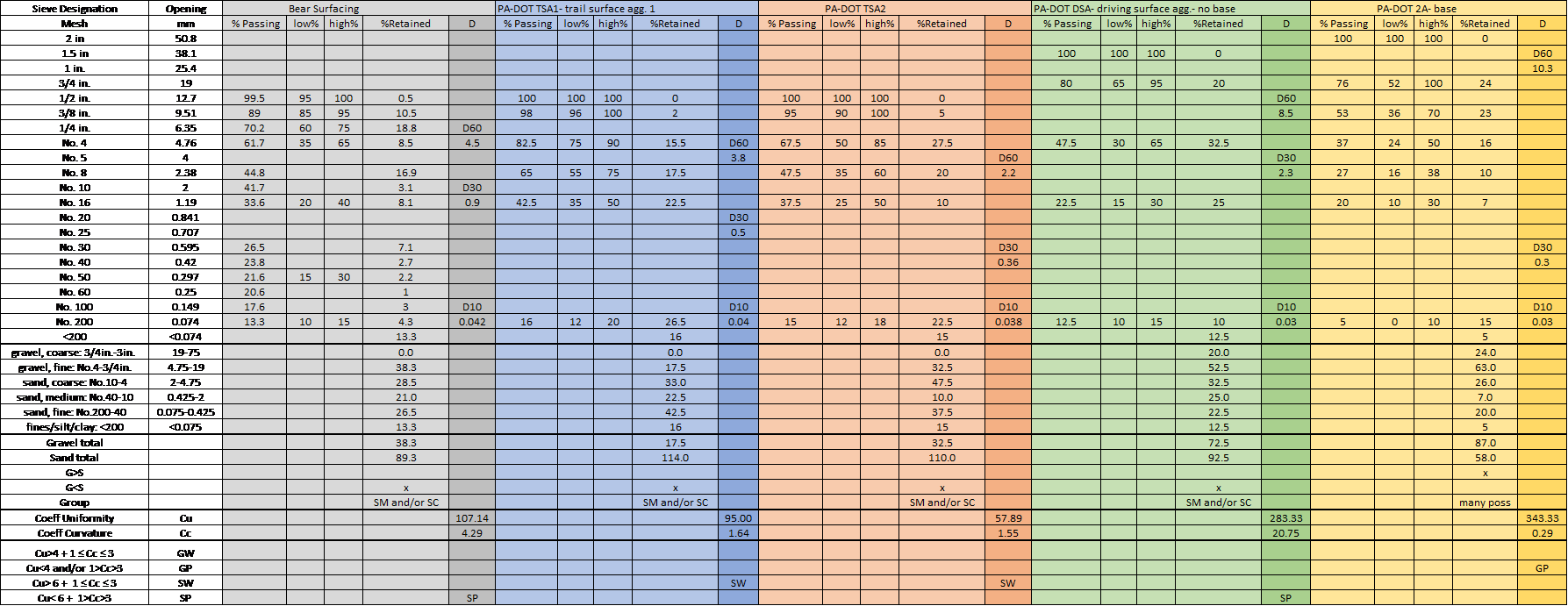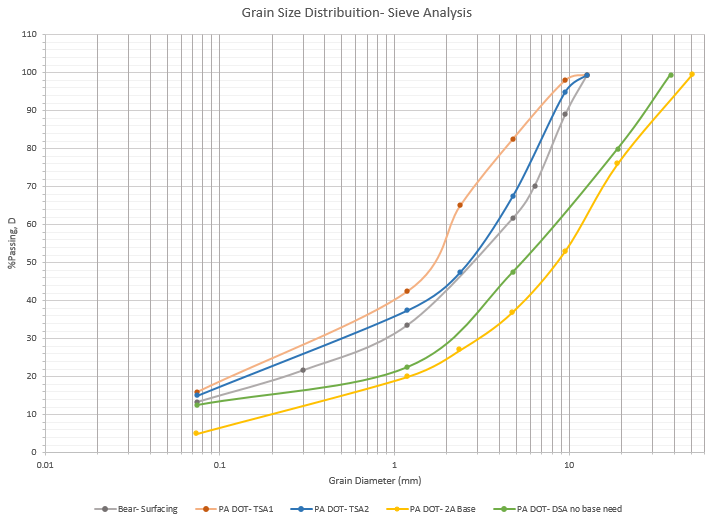- If aggregate materials are going to be used for the repair or surfacing of trails, consider the preceding table and corresponding graph as general guidelines for materials.
- Definitions:
- PA DOT (Pennsylvania Department of Transportation, and Penn State Center for Dirt and Gravel Road Studies)
- D60 = Diameter when 60% passes, 40% retained
- D30 = Diameter when 30% passes, 70% retained
- D10 = Diameter when 10% passes, 90% retained, AKA the “effective range” which is correlated w/ the permeability of finer grains
- Cu = (Hazen) Coefficient of Uniformity = particle size range ratio: Cu = D60/D10
- Cu < 5 Very Uniform, and may need envelope(geotextile) or an intermediate layer
- Cu = 5 Medium Uniform
- Cu > 5 Non Uniform
- Cc = Coefficient of curvature = measures particle size curve shape: Cc = (D30)^2/(D60xD10)
- Cc from 1 to 3 are typically well graded
- GW/GP (Graded Well/Poor for Gravels); SW/SP (Graded Well/Poor for Sands)
- Well graded soils have a wide range of particle sizes
- Definitions:
- The boundary between gravelly and sandy soils is a range, not a point, and not critical for soil behavior.
- The minimum depth of compacted aggregate should be three times the largest stone diameter. However, PA DOT recommends a 3 inch compacted minimum for the TSA mix.
- When ordering materials, request a “Plasticity Index” using ASTM D4318 to show the range of soil water content where the soil exhibits plastic properties: (0-3)- Non-plastic, (3-15) – Slightly plastic, (15-30) – Medium plastic, >30 – Highly plastic. Less than 6 is preferred. Many DOTs strive for a plasticity index and the liquid limit of the minus No. 40 less than 6% and 25%.
- Soil tests may be needed should surfacing be applied to determine geotextile needs for load bearing capacity and trail longevity
- For longevity also consider compacting aggregates at optimum moisture content (table below):
| Typical compacted densities and optimum moisture contents for USCS soil types (after Carter and Bentley, 1991). | ||||
| Soil Description | USCS Class | Compacted Dry Unit Weight | Optimum Moisture Content (%) for compaction | |
| (lb/ft3) | (kN/m3) | |||
| Gravel/sand mixtures: | ||||
| well-graded, clean | GW | 125-134 | 19.6-21.1 | 8-11 |
| poorly-graded, clean | GP | 115-125 | 18.1-19.6 | 11-14 |
| well-graded, small silt content | GM | 119-134 | 18.6-21.1 | 8-12 |
| well-graded, small clay content | GC | 115-125 | 18.1-19.6 | 9-14 |
| Sands and sandy soils: | ||||
| well-graded, clean | SW | 109-131 | 17.2-20.6 | 9-16 |
| poorly-graded, small silt content | SP | 94-119 | 15.7-18.6 | 12-21 |
| well-graded, small silt content | SM | 109-125 | 17.2-19.6 | 11-16 |
| well-graded, small clay content | SC | 106-125 | 16.7-19.6 | 11-19 |
References:
- US Dept. of Agriculture, USFS: Environmentally Sensitive Road Maintenance Practices for Dirt and Gravel Roads
- Penn State Center for Dirt and Gravel Road Studies: Trail Surface Aggregate (TSA) Technical Bulletin PA DOT 2014
- Uelph Turfgrass Institute, Dr. R.W. Sheard: Drain Envelopes, Sports Turf Management 3/99
- HQ Dept. of Army, Materials Testing, The Unified Soil Classification System (USCS), FM 5-472 NAVFAC MO 330 AFJMAN 32-1221(I)
- Carter and Bentley, Correlations of Soil Properties, 1991
More:
- Gravel Roads Maintenance and Design Manual
- What is Good Gravel?
- Road Aggregate 101
- Plasticity requirements of aggregates used in base and sub base course
- Driving Surface Aggregate (DSA) and plasticity index
7. Gravel Base Course and Surfacing Table: recommended size distributions (see#1 1-7 for explanations)

8. Graph: Recommended size distributions (see#3 for explanation)
